If you wonder why your child continues to struggle academically perhaps they may be struggling with a learning disability. Challenges involving reading, writing, math, organization, concentration, listening, comprehension, motor skills and social skills all may be signs of a potential issue.
Table of Contents
ToggleHowever, you should know that you’re not alone! One in five kids has a learning disability, dyslexia and/or attention deficit problems.
LD Resources Foundation has made available a Self-Test for you and your child to determine whether your child shows symptoms similar to those of a learning disability.
[sdfile url=”https://www.ldrfa.org/wp-content/uploads/2018/01/LDRFA-Checklist-LD-Dyslexia.pdf”]
*Note* only a trained educational psychologist utilizing a comprehensive clinical evaluation can make the diagnosis of a learning disability etc. LD Resources’ self-test is for personal use (general guidance) only
Fifteen percent of the U.S. population, has some type of Learning Disability, Dyslexia and/or ADHD, according to the National Institutes of Health. Of those children receiving special education services, 35 percent had a specific learning disability, 20 percent had speech or language issues and 13 percent had other health impairments.
A Learning Disability is a neurological disorder caused possibly by genetics or environmental/ medical issues. People with learning disabilities and challenges may have difficulty reading, writing, spelling, reasoning, recalling and/or organizing information, working at a job, as well as problems with memory. Up to 60% of adults with literacy problems may have undetected Learning Disabilities. Some individuals don’t realize they have a Learning Disability such as dyslexia, dysgraphia, dyscalculia, ADHD or difficulty with Social Skills until they are adults. Associated problems with socialization are often missed or overlooked in school. These conditions can, if not properly addressed, lead to a lack of self-esteem and other stigmas that may greatly affect your child’s learning experience.
According to the National Institutes of Health (NIH), Learning Disabilities “are caused by differences in brain structure and affect the way a person’s brain processes information. It is not an indication of a person’s intelligence”.
Nowadays, parents and teachers are more aware of Learning Disabilities than in the past. Today, most Learning Disabilities are identified at around 5 years of age, when the child begins school. You should know that there are three Federal Laws that protect the rights of children and adults with disabilities and being aware of them and understanding your rights will be of great benefit. They are as listed:
- Americans with Disabilities Act (ADA)
- Individuals with Disabilities Education Act (IDEA)
- Section 504 of the Rehabilitation Act
Learn more about self-advocacy
Common signs that a person may have learning disabilities include the following:
- The difficulty with reading and/or writing.
- Problems with math skills.
- Difficulty remembering.
- Problems paying attention.
- Trouble following directions.
- Poor coordination.
- The difficulty with concepts related to time.
- Problems staying organized.
Awkwardness when running, jumping, skipping; bumping into objects, falling frequently, difficulty with buttoning, zipping, using scissors, catching or hitting a ball can actually be symptoms of a Learning Disability or related condition.
If you suspect that your child may have a learning problem, please take the necessary steps to have your child evaluated. Early intervention leads to increased performance and helps to increase general learning ability. Without early intervention, there is a greater chance that a Learning Disability may affect a person’s self-image. (gene tag our block for self image). LD/Dyslexia affects individuals throughout their lives, however with appropriate teaching and with the right interventions, the person has a good chance of succeeding in the educational system and in life. Some go on to have distinguished careers later in life, such as Michael Phelps (ADHD) and Steven Spielberg (Dyslexia). Famous people with learning disabilities
A Learning Disability can’t be cured however, with support from the educational system, it can become manageable. One very helpful, easily obtainable relatively basic technology (there are many more advanced programs available, as well) that can be found on all computers and smartphones :
- Assistive Technology: this provides the tools that offer support and allows independence for Learning Disability students. Assistive technology tools help by utilizing spell checks, grammar checks and vocabulary building like word prediction tools and notetaking.
Students can download from libraries their digital textbooks or recorded audiobooks, allowing a struggling reader to complete their reading assignments and often these library services are free of charge. Click here.
For a complete overview of Assistive Technology tools organized by categories click here
Early intervention is the KEY to the successful education of a child!
A Learning Disability can always be made manageable, however a child’s best chance comes with the support of a knowledgeable parent, one who has clear goals and will advocate for their child.
LDRFA.ORG offers grants for free assistive technology. If you are struggling with Learning disabilities we offer an AWARD PROGRAM. Click Here To Apply
Resources:
- https://www.nimh.nih.gov/health/topics/attention-deficit-hyperactivity-disorder-adhd/index.shtml
- http://brainresourcecenter.com/add-adhd/?gclid=CLa78Jzt2tACFVWBswoddCYN-Q
****************************************************************************************************
Related Blogs
1.https://www.ldrfa.org/learning-disability-adhd-facts/
2. https://www.ldrfa.org/learning-disability-adhd-facts/educational-strategies/


